How Aston Villa destroyed Liverpool — but why Jurgen Klopp's high line isn't the problem
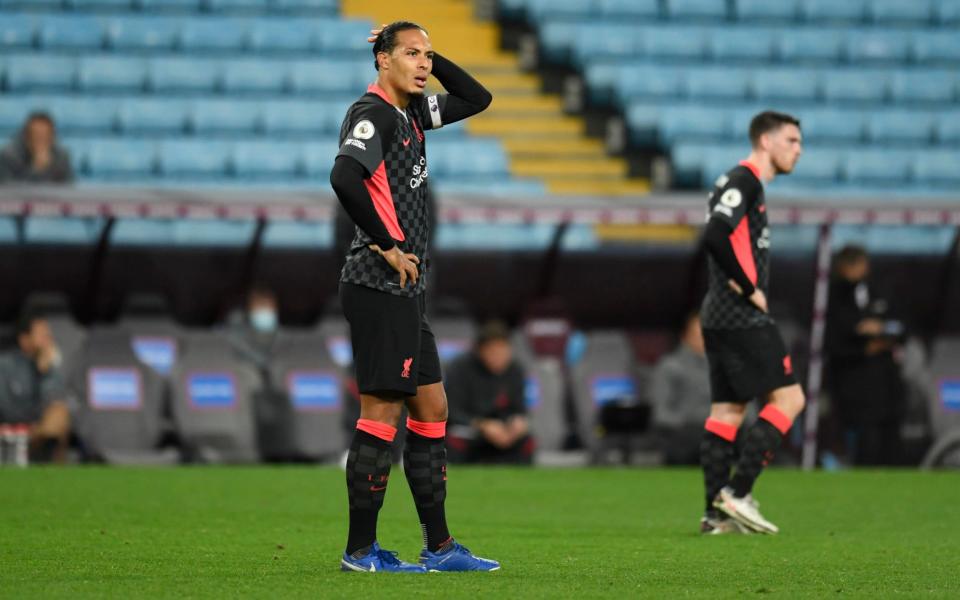
After Aston Villa's stunning 7-2 win over Liverpool, questions have been asked as to how a team who narrowly avoided relegation were able to destroy Jurgen Klopp's all-conquering champions in one of the most surprising Premier League results in memory.
The 18 shots Aston Villa had on goal is the joint-most Liverpool have ever conceded in the Premier League under Jurgen Klopp. West Ham are the only team to better their 13 shots taken inside the box since 2015/16, once having 14 efforts on goal from inside the area back in January 2016. Since that dark day, Liverpool have won the Champions League and the Premier League. Klopp's system isn't exactly broken, so why didn't it work against Villa?
Dean Smith's gameplan
Aston Villa had done their homework. "We saw how high they play and the game plan was to try and get in behind them and you could see it worked," said Ollie Watkins in his post-match interview, a player who was fundamental in making Dean Smith's gameplan function properly.
Although a central striker, Watkins regularly drifted out to the left so he could attack the Trent Alexander-Arnold-Joe Gomez side of defence and cut onto his right foot, moving into space to facilitate quick counter-attacks. This was necessary, with Liverpool enjoying 81 per cent of possession in the opening 20 minutes, despite finding themselves 1-0 down thanks to a hospital pass from Adrian inside his own box.
Teams are so worried about Liverpool's attacking threat that they naturally drop ever deeper to protect their own box, allowing the full-backs to get high up the pitch and Klopp's side to dominate possession. The aim is to defend in numbers then hurt Liverpool in transition, which is exactly how Villa scored their second.
With a rare chance to keep the ball after sustained Liverpool pressure, Jack Grealish threads Watkins into the space between centre-back and right-back on the left wing.
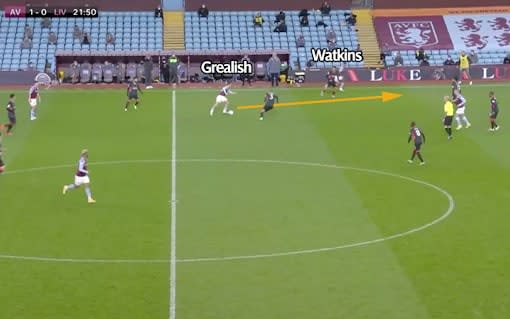
Watkins makes the run from a deep starting position and is at full speed by the time he controls the ball, sprinting behind the last line of defence. Liverpool's back four (minus Alexander-Arnold) run back towards their own goal.
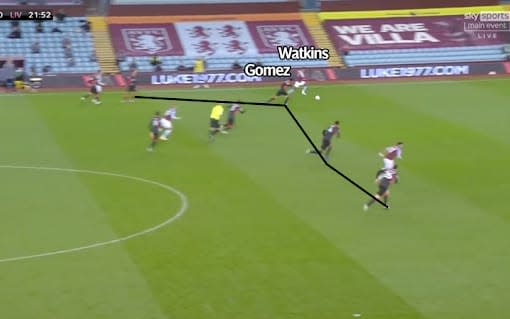
Watkins is shown wide by Gomez, who doesn't get tight early enough and leaves himself off-balance while slowing down. Watkins cuts onto his right and moves into the space behind the defender.

Gomez has been easily beaten one v one, and Watkins finishes superbly into the top corner. Liverpool are caught out by a clinical counter-attack from Villa, a slight positional error from Alexander-Arnold, poor one v one defending from Gomez, and an incredible shot by Watkins.
A high line is not the problem
Some managers prefer to sit behind the ball and minimise space in a compact block, like Diego Simeone's Atletico Madrid, others force their opponents far away from their own goal, like Klopp's Liverpool, defending by attacking. There are plenty of pragmatic in-betweeners too but Klopp's favoured set up is one which allows him to control the game with and without the ball, creating as few unpredictable random scenarios within a game as far up the pitch as possible.
There was little Klopp could have done on the training ground to prevent John McGinn's deflected volley from the second phase of a corner for the third goal, but there are signs he has work to do elsewhere. Opposition managers have begun to spot gaps in Liverpool's previously impenetrable armour and Villa's fourth goal was an example of this, as the only goal they scored which wasn't either direct punishment of an error, or from a counter-attack.
The defence sets up with a high line from a set piece about 35 yards from goal. The theory makes sense: if the defence were to drop to the red line, as teams have traditionally done, Villa's most dangerous attackers - the centre-backs - would be closer to goal, potentially leading to a scoring chance for the attacking team from a well delivered cross.
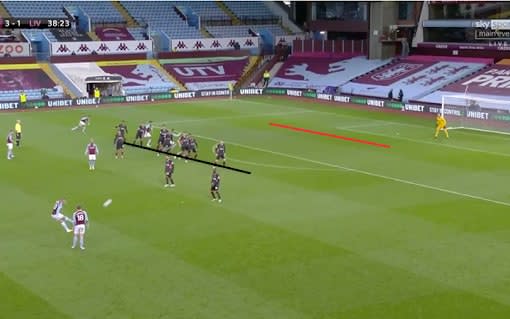
"We worked on the opposite switch to some deep runs and we made some great runs," said Dean Smith after the match."That's what we wanted to do. We felt they've got such a good team shift that whenever we passed the ball we reversed it to the opposite side, and we felt that's where the space would be."
By planning this set-piece around an extra phase and attacking the wide space rather than the box, Villa were able to create a big chance to score. Liverpool's compact block left the runner on the left wing completely free. Ross Barkley aims his cross around the wall into Trezeguet's path (circle).

The delivery is excellent and curls around the line. Liverpool players turn believing they have easily nullified another free-kick with their defensive positioning, only to discover Trezeguet has beaten the trap. The ball follows the blue arc below, with Liverpool's entire team compacted into the black triangle, leaving the white space free on the opposite side.
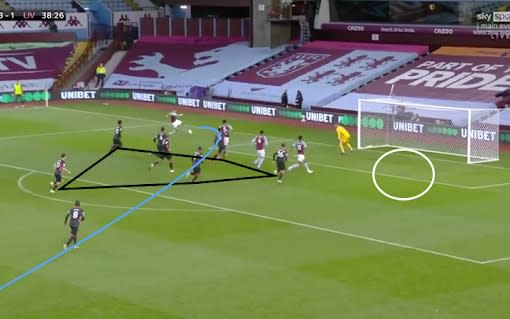
As soon as Trezeguet reverses the pass to the back post, Watkins heads - unmarked - into an empty net.
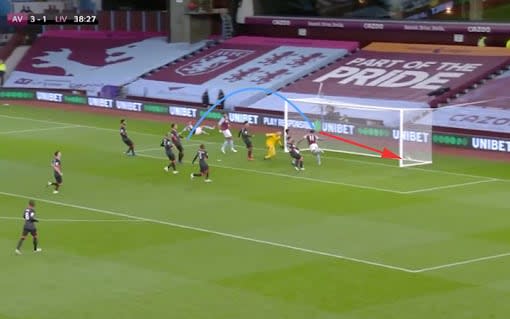
Had Liverpool started this set piece with a deeper line, they would have invited a different sort of pressure. There's no right or wrong way to defend - Klopp's coaching staff have simply chosen this higher line to make the opposition work harder to get closer to their goal.
Individual errors
Although Liverpool looked unbeatable for much of 2019/20, vulnerabilities shown towards the end of the season haven't gone away. Klopp's "mentality monsters" are human after all.
"We made too many mistakes and massive ones obviously," said Klopp. "It started with the first goal and around the goals we made massive mistakes.
"We lost balls in the wrong area and did not protect properly. It looked like we lost the plot after it went to 1-0. It is not an excuse."
Gomez was guilty of a few errors, the most obvious being his under-hit pass to Gini Wijnaldum which led to Villa's fifth. Watkins reads the pass early and steps in to intercept.
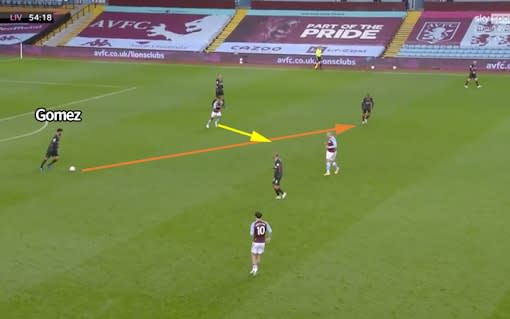
Klopp had already made a substitution at half time, switching to a 4-2-3-1 from a 4-3-3 with Takumi Minamino brought on for Neiby Keita, and a confidence-rattled Liverpool are a little unsure of themselves at this point.
Villa played a diamond around Liverpool's newly introduced double pivot, exploiting the space (red arrows) left between midfield and centre-backs and midfield to full-backs.
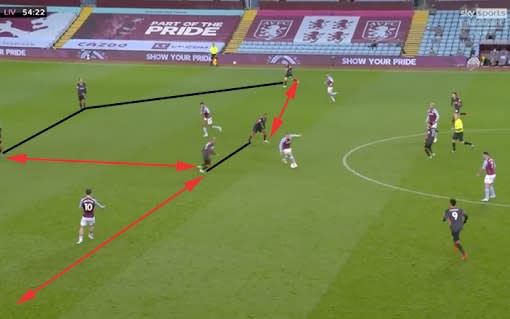
Liverpool's centre-backs had already started to drop deeper in defensive phases, defending in a less aggressive manner than the first half as a natural reaction to being 5-1 down. Jack Grealish receives the ball in space, Targett instantly makes an overlapping run. Mohamed Salah doesn't bother tracking him.

Targett's run alters Alexander-Arnold's positioning, which allows Grealish to find Barkley... who gets one of the luckiest deflections of all time to beat Adrian in the goal.

This is one of the problems with analysing such a bizarre game - Liverpool actually do most things right in reacting to Gomez's error but Alexander-Arnold's leg completely changes the direction of the shot and it's a goal. What is a manager to do?
Seriously, the problem really isn't the high line
Mistakes and deflections gave Villa the incredible lead their hard work and preparation deserved. Grealish's position on the left, and Watkins' tendency to drift out to that channel meant Smith's team focused 40.1 per cent (the majority) of their attacks on that side, which is also what Arsenal did (37.4 per cent), and Chelsea (39.3 per cent), and Leeds (48.8 per cent)... with Premier League managers attacking that side again and again as though the secret to defeating the final boss in a video game.
Alexander-Arnold's attacking wont is one reason for this, another might be that managers feel Gomez is a weak link. His performance against Villa suggests there may be truth behind that theory but while opposition managers believe they can exploit defensive weakness in the Alexander-Arnold, Gomez partnership - something Klopp will have noticed - he won't have expected his side to be so passive in the midfield battle.
Below, Virgil Van Dijk attacks a long punt from the goalkeeper. Liverpool's midfield are in a narrow shape ahead of him (black), Villa are wider in more of a diamond.
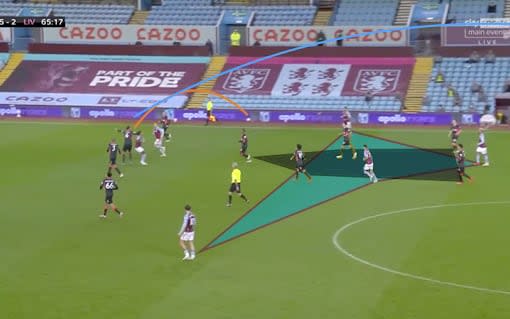
Villa players 'want it more', and Minamino doesn't deal with the high ball well, catching it with his shoulder. As soon as this ball bounces loose Villa have players wide in space ready to receive. Alexander-Arnold has dropped level with his centre-backs rather than staying tight to Grealish.

The ball bounces towards Firmino, who is out-muscled by McGinn then beaten to the ball by Trezeguet. Liverpool's midfield has disappeared, giving Villa a run at the back line.
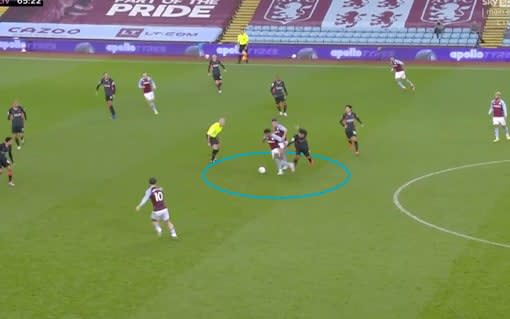
Grealish has a little bit of freedom due to Alexander-Arnold dropping deeper and Salah never running back past halfway, gets to the box and Alexander-Arnold tries to show him wide. A quick shimmy allows Grealish to shift the ball onto his right foot and curl a shot towards the far post...

And again, it takes an enormous deflection and flies into the exact opposite part of the goal intended. Liverpool's high line is designed to eradicate the sort of second ball aerial battle situations as above and the aggressively positioned full-backs are supposed to be tighter to opposition wingers to force them deeper. Nobody can do anything about the finish.
But really, the high line isn't the problem
Villa's final goal brings us back full circle to the supposed issues with Liverpool's high line. Jamie Carragher explained the risks of this line after the match:
"For me, even though Liverpool have got a good defensive record, I don't like them trying to catch teams offside," he said. "I don't agree with it. Being a defender and having played that position myself this team play a lot higher up the pitch. They almost sacrifice one big chance a game with the opposition going through on goal.
"When someone beats your press around midfield and they're not far from your back four you've got to get ready to go back."
The high risk strategy has been high reward for some time but the natural consequence is that when the press doesn't work, the defence is left vulnerable to on-running players. However, even though Villa's seventh goal was a direct example of the danger of playing a high line, the real problem with the goal comes earlier.
With Liverpool deflated and confused, and Villa brimming with confidence, a throw-in is hurled up the pitch. Curtis Jones, on as a substitute, doesn't go in with the aggression or determination needed to win the header.
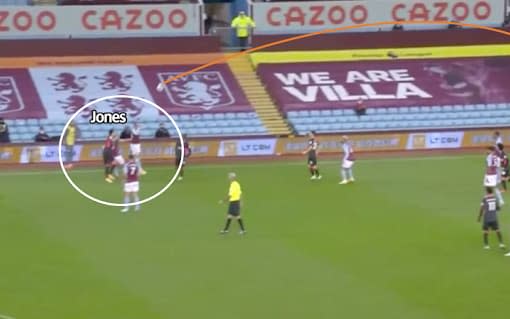
The ball bounces into midfield for another aerial battle. Liverpool are pushed high and in a compact shape to restrict the size of the pitch and win second balls, hoping to turn this transitional phase into a quick attack with players ready to run. None of this matters if they don't compete in duels.

Because James Milner also doesn't win his header, suddenly Villa are the ones with the advantage. Alexander-Arnold spots the danger and runs towards his own box but it's too late. McGinn fires a long pass in behind.
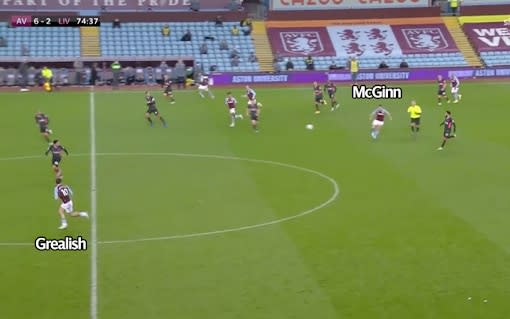
Grealish runs through and beats Adrian one v one. The high line means Grealish is able to get behind the defence but had the midfield won any of those headers, Liverpool would have been well placed to attack high up the pitch. If it works against Barcelona, there's a fair chance Villa might be susceptible to pressure too.
Some of the post match criticism from in the Sky Sports studio was of Liverpool's naivety at continuing to defend with a high line when the game had already gone, but this is simply how Liverpool defend. That's the system. By keeping the opposition further away from goal, the opposition has more space to cover to reach the goal. Klopp's team has been rightly praised for their clear attacking identity, and while adapting at 5-1 down might have helped locked the defence, it may also have invited more pressure.
Sadio Mane's absence was keenly felt, with Diogo Jota perhaps not quite to speed with the fluid, machine-like manner that Klopp's side usually presses with in-game. Any side would miss Mane, one of the world's best players, but Klopp's high pressing system is particularly reliant on his energy and leadership, inspiring those around him by charging at defenders, chasing the ball down no matter how lost or pointless the cause appears.
"When there is no Mane, there is no party because he is the one giving the pressure," Patrice Evra said after the game.
"Firmino is not an aggressive player, Salah is not an aggressive player, so I think they missed Mane a lot."
Liverpool are ferocious in attack and defence but aren't perfect, and if the first and second lines of press are bypassed, have to transition to a defensive shape swiftly like any other side. Liverpool's solution to avoiding these transitional phases is to catch their opponents offside at halfway and kill the danger at the earliest possible opportunity. It has tended to work in the past.
The system works but individual errors by players within it help explain this defeat but the worrying ease with which opponents are hurting Liverpool on the counter-attack is a cause for concern. The cloak of invincibility has gone and the wave of momentum that Klopp's players surfed on their way to the title has settled a little... but there is no need to panic. Villa planned well, worked hard and enjoyed good fortune.
As Dean Smith said at the final whistle, "When Jurgen Klopp says 'wow' to you at the end you know you've done something right'".

 Yahoo Sport
Yahoo Sport 





































